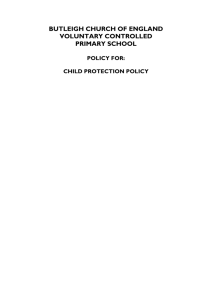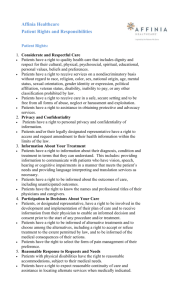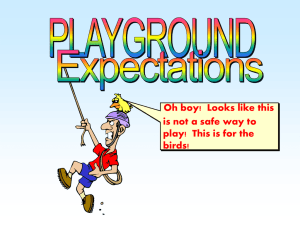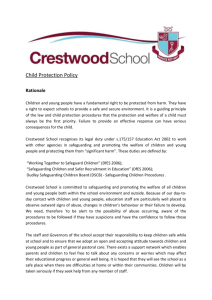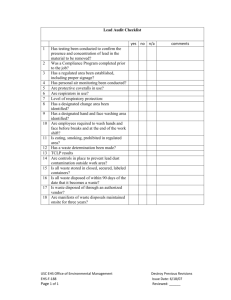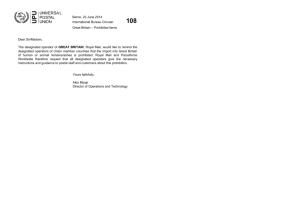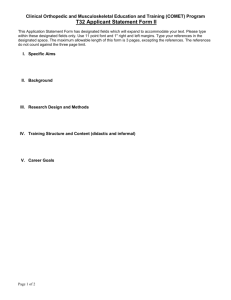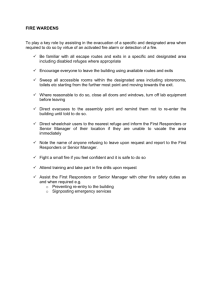School Policy for PSHE and Citizenship
advertisement
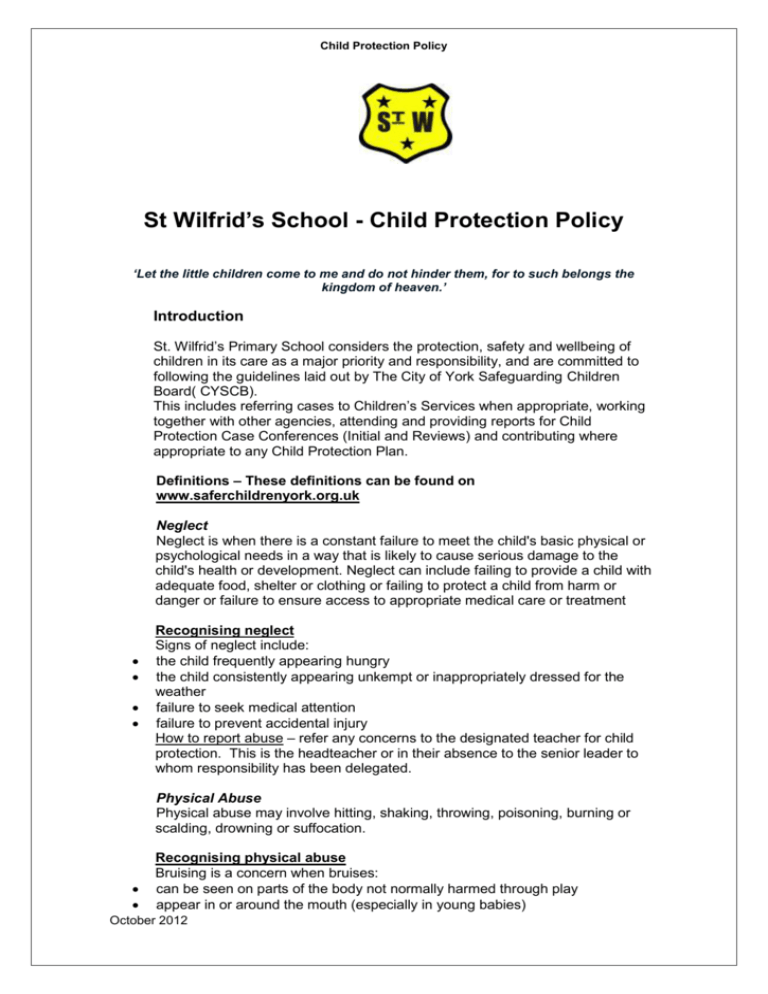
Child Protection Policy St Wilfrid’s School - Child Protection Policy ‘Let the little children come to me and do not hinder them, for to such belongs the kingdom of heaven.’ Introduction St. Wilfrid’s Primary School considers the protection, safety and wellbeing of children in its care as a major priority and responsibility, and are committed to following the guidelines laid out by The City of York Safeguarding Children Board( CYSCB). This includes referring cases to Children’s Services when appropriate, working together with other agencies, attending and providing reports for Child Protection Case Conferences (Initial and Reviews) and contributing where appropriate to any Child Protection Plan. Definitions – These definitions can be found on www.saferchildrenyork.org.uk Neglect Neglect is when there is a constant failure to meet the child's basic physical or psychological needs in a way that is likely to cause serious damage to the child's health or development. Neglect can include failing to provide a child with adequate food, shelter or clothing or failing to protect a child from harm or danger or failure to ensure access to appropriate medical care or treatment Recognising neglect Signs of neglect include: the child frequently appearing hungry the child consistently appearing unkempt or inappropriately dressed for the weather failure to seek medical attention failure to prevent accidental injury How to report abuse – refer any concerns to the designated teacher for child protection. This is the headteacher or in their absence to the senior leader to whom responsibility has been delegated. Physical Abuse Physical abuse may involve hitting, shaking, throwing, poisoning, burning or scalding, drowning or suffocation. Recognising physical abuse Bruising is a concern when bruises: can be seen on parts of the body not normally harmed through play appear in or around the mouth (especially in young babies) October 2012 Child Protection Policy appear as small 'grasp' or finger marks to a child's arms or legs look like they have been caused by a stick or belt appear to be of different ages (colour) in the same area appear the same on both sides of the body, legs, head or arms appear as bite marks especially when the marks appear to be those of an adult or older child (more than 3cm across) Most fractures are treated by a hospital. It is concerning when a child is not taken for treatment if they are suffering pain, swelling or discolouration over a bone or joint. Although it may not always be possible to know whether a child has a fractured bone it is difficult for a parent or carer to be unaware that the child has been hurt. It is rare for children under the age of one to sustain a fracture accidentally. It can be difficult to distinguish between a burn or scald that has been caused accidentally or non-accidentally. As with fractures all burns and scalds should receive medical treatment. How to report abuse – refer any concerns to the designated teacher for child protection. This is the headteacher or in their absence to the senior leader to whom responsibility has been delegated. Sexual Abuse Sexual abuse involves forcing or enticing a child or young person to take part in sexual activities, whether or not the child is aware of what is happening. Sexual activities may involve physical contact such as sexual intercourse, buggery or non-penetrative acts. Sexual activities may also include non-contact activities like involving children in looking at pornography, creating pornography, watching sexual activities or encouraging children to behave in sexually inappropriate ways. Recognising sexual abuse Signs of sexual abused include: sexually explicit talk or play, especially in prepubescent children sexual behaviour, such as pretending to have sex during play sexually provocative relationships with adults itching, redness, soreness or unexplained bleeding from a child's vagina or anus bruising, cuts or marks to the genital area repeated genital infections How to report abuse – refer any concerns to the designated teacher for child protection. This is the headteacher or in their absence to the senior leader to whom responsibility has been delegated. Emotional Abuse Emotional abuse is when a child is deprived of love, warmth and affection or is persistently treated negatively, inconsistently, inappropriately or is rejected. This may include the child being constantly told that they are worthless, unloved or inadequate or the parent or carer having unreasonable and unrealistic expectations of the child's abilities or making the child being made to feel frightened or in danger. Recognising emotional abuse Signs of emotional abuse include: very low self esteem, often with an inability to accept praise or trust in adults excessive clinging and attention seeking behaviour October 2012 Child Protection Policy over anxious - being excessively 'watchful', constantly checking or being over anxious to please withdrawn and socially isolated How to report abuse – refer any concerns to the designated teacher for child protection. This is the headteacher or in their absence to the senior leader to whom responsibility has been delegated. It should be noted that these categories may overlap Roles and responsibilities The school recognises and accepts that teachers, along with other adults associated with the school, because of their unique position, are well placed to observe children and note any emotional, behavioural or physical signs which may be suggestive of child abuse or have concerns about their care. We recognise that the relationship between teachers, pupils and parents which fosters respect, confidence and trust can lead to the disclosure of abuse. Recognising the necessity and nature of good relationships with parents of children in its care and attempting to preserve these wherever possible, the school, however, acknowledges that the child’s protection is paramount. Schools are supported in all matters relating to Child Protection by the Education Social Work Service who are available to give advice, support and guidance regarding child protection matters. In order to prepare all staff for their responsibility in relation to the protection of children, they have received basic child protection awareness training. New staff are made aware of child protection issues on induction and receive training. School will always follow the procedures as defined by the CYSCB. All staff (teaching and non-teaching) have read this policy and reviewed the procedures and referrals chart. There is a central record of all staff and their training/knowledge of child protection. List of Staff Headteacher - Designated Teacher for Child Protection. All newly appointed staff will be made aware of this policy and become familiar with the policy and procedures on induction. The senior member of staff with designated responsibility for child protection is the headteacher. She will liaise other staff where appropriate. The nominated governor for child protection is Eileen Sparks (chair). School Procedure for Staff Any member of staff who: October 2012 Child Protection Policy a has suspicion that a child is injured, marked, or bruised in a way which is not readily attributable to the normal knocks or scrapes received in play, or when the explanation given appears inconsistent with the injury; b notes behaviours or actions, which give rise to suspicions that a child may have suffered abuse (may include worrying drawings or play); c is concerned that a child may be suffering from lack of care, ill treatment, or emotional maltreatment; d has concerns that a child is presenting any signs or symptoms consistent with suspicion of child abuse or neglect; e notes significant changes in a child’s presentation otherwise unexplained; f receives hints or a disclosure of abuse from the child, another pupil, parent or member of the public; g becomes aware that a Schedule 1 offender has moved into a household with children present or otherwise in a situation where that person may be posing a risk to children; Must immediately report this to the designated child protection teacher, including any notes or observations. It is important that staff only comment on observation and fact and do not hypothesize. Remember a It is not the responsibility of teachers/care/support staff to investigate abuse or decide if abuse has taken place. The school does, however, have a duty to act on any concerns and refer to the investigating agencies (Social Services and the Police). b Always listen to and take seriously any disclosure of abuse. Keep questions to a minimum, only asking these to clarify information or to assist the child who is finding it difficult to talk. Any questions should be ‘open’ i.e. not have the answer embedded in the question e.g. ‘Can you tell me what happened’ rather than ‘Did x hit you?’ c Do not interrogate the child. Do not make the child repeat it all to another person. The information needed from the child is only that which is sufficient to make a referral for further investigation, not for staff to decide the validity of the disclosure. d Try not to show signs of shock, horror or surprise. e Do not express your feelings or any judgements regarding the alleged abuser. f If a child confides in you and requests that the information is kept secret, it is important that you tell the child sensitively that you have a responsibility to refer the information to the Designated Teacher for Child Protection (SMO) in order to protect the child from further abuse. ON NO ACCOUNT SHOULD THE CHILD BE PROMISED ABSOLUTE CONFIDENTIALITY. g Reassure and support the child, as far as possible, that only those who ‘need to know’ in order to protect them will be told. Explain what will happen next and try to ensure that the child is involved as far as possible and appropriate. October 2012 Child Protection Policy h Do not approach parents at this stage - the Designated Teacher for Child Protection will decide, based on the information, if and when parents will be spoken to. i Child protection information is CONFIDENTIAL and will be shared only on a ‘need to know’ basis as determined by the designated/head teacher. Action by the Designated Teacher for Child Protection ( The headteacher) a. Staff will immediately inform the Designated Teacher for Child Protection of their concerns. In the absence of the Designated Teacher for Child Protection staff will inform another senior member of school staff to whom responsibility has been delegated. b. The Designated Teacher for Child Protection will decide what needs to happen next. The first consideration will be the need to address any urgent medical needs of the child. c The Designated Teacher for Child Protection is entitled to make an enquiry as to whether the child is on, or has been on, the Child Protection Register City of York Safe Guarding Children Board - (01904) 551900 d The Designated Teacher for Child Protection can consult with the ‘Front Door’ team (The Children’s Advice and Assessment Service) telephone 551900 for support and advice about how to proceed. They may also consult with the Children’s Services Referral and Assessment Manager or a Referral and Assessment social worker (Service Manager and Senior Practitioner) based at Ashbank (telephone 01904 551900). e The Designated Teacher for Child Protection will decide, based on CYSCB guidance, whether to see informal Child protection advice , and if necessary after consultation as above, whether to talk to parents. Good child protection practice rests within a climate of openness and honesty. Parents will in general and where possible be spoken to unless to do so may place the child at risk of significant harm, impede any police investigation or place the member of staff or others at risk. An inability to contact parents will not cause undue delay in making a referral. The Designated Teacher for Child Protection will not fail to make any necessary child protection referral if the parents disagree with this decision. The Designated Teacher for Child Protection will make it clear that they are following City of York Safe Guarding Children Board and acting on their statutory duty. The Designated Teacher for Child Protection will decide whether to make a formal referral to Children’s Services via City of York Safe Guarding Children Board to report concerns to Children and Family Services tel: (01904) 551900. Outside office hours, at weekends and on public holidays contact the emergency duty team tel: (0845) 0349417. This would then be followed up in writing using the standard referral form. f In cases where the child is at immediate risk, there is clear physical evidence or the child has made a clear disclosure, referral to should be made immediately. If the above consultation process is not possible or October 2012 Child Protection Policy cannot be completed within a very short timescale (because for example the Designated Teacher for Child Protection is not available) then it is the responsibility of the teacher who gleaned the information to ensure that a speedy referral is made to Children’s Services. Any member of school staff is entitled to liaise/consult and to make a referral. Absence of key personnel should never prevent a referral when there is immediate risk, evidence or direct disclosure. g If it is decided not to make a referral at this stage, the action taken should be fully documented, together with the reasons for the decisions not to proceed further. The Designated Teacher for Child Protection may advise that further monitoring is necessary. Parents will be informed (please give regard to paragraph e above). h The Designated teacher for Child Protection may consider that whilst a child protection referral may not be appropriate, it would be appropriate to make a referral for family support from Children’s Services or other services such as, for example, School Health Service; Primary Mental Health Worker for Child and Adolescent Mental Health; Education (Education Social Work, Behaviour Support, Learning Support, Educational Psychologist). A Common Assessment form (CAF) should then be completed to ensure that all relevant information is shared with other agencies. This should only ever be done with the agreement of parents. However, failure to agree may, in some circumstances, itself be a child protection concern. Action Following Child Protection Referral a The Designated Teacher for Child Protection will make regular contact with Children’s Services to provide any necessary information and ensure that they are up to date, clear about any action being taken by them, and clear of any action for school to take. b The Designated Teacher for Child Protection or other appropriate member of staff will, wherever possible, contribute to the strategy discussion. c The Designated Teacher for Child Protection or other appropriate member of staff will attend, contribute to, and provide a report for, any subsequent Child Protection Conference. This will include expressing a professional view, based on the information shared as to whether the child or children subject of the Conference should be placed on the Child Protection Register on the grounds that they appear to be at risk of continuing significant harm. d If the child or children are placed on the Child Protection Register, the school will contribute to the Child Protection Plan, attend Core Group Meetings and Review Child Protection Case Conferences. e All reports written will, wherever possible, be shared with parents prior to meetings. If we are in doubt regarding sharing certain information we will discuss with a senior member of the ESW staff. f Where the Designated Teacher for Child Protection disagrees with a decision made by Children’s Services e.g. not to apply Child Protection Procedures or not to convene a Child Protection Case Conference, he/she will discuss this with a senior member of the ESW staff and they will together agree how to proceed. October 2012 Child Protection Policy Recording and Monitoring Accurate records will be made as soon as practicable and will clearly distinguish between observation, fact, opinion and hypothesis. All records will be signed and dated, any information given be recorded verbatim where possible and note made of location and description of injuries seen. The Designated Teacher for Child Protection has agreed the following system of monitoring and review with staff. All child protection documents will be retained in a ‘Child Protection’ file, separate from the child’s main file. This will be locked away and only accessible to the headteacher and Designated Teacher for Child Protection. The Data Protection Act 1998 provides that child protection records be exempt from disclosure where this would not be in the best interests of the child. These records will be transferred to any future school the child moves to, clearly marked: Confidential - Child Protection - for the attention of Designated Child Protection Teacher. Partnership with Parents St. Wilfrid’s RC Primary School recognises that the protection of children should always be of paramount importance and consideration and that the primary focus in child protection should always be the child’s safety and welfare. However, good child protection practice and outcome relies on a positive, open, honest working partnership with parents. We will ensure that all parents are treated with respect, dignity and courtesy. We will respect parents right to privacy and confidentiality unless they give permission for information to be shared or it is necessary to infringe this in order to protect the child or children. When a referral has been made without informing parents (see Action by Designated Teacher for Child Protection Section e) we will clearly explain that we have acted: a following consultation, and b in line with our statutory responsibilities, this policy and LA and CYSCB Guidelines and Procedures. This policy is available to parents on request, although we may, on occasion, need to make referrals without consultation with them. We will, however, make every effort to maintain a positive working relationship with parents whilst fulfilling our duties to protect the child or children. Supporting the Child The school will continue to support the child and work together with other agencies involved with the family. Children will be given a proper explanation (appropriate to age and understanding) of what action is being taken on their behalf and why. We will provide a secure, caring, supportive and protective relationship for the child. The head teacher/Designated Teacher for Child Protection will decide which members of staff “need to know” and how much they “need to know” in order to October 2012 Child Protection Policy support and protect the child. This will take into account the acute difficulty and embarrassment many children have knowing that staff are aware of their situation. Central to the decision will be the need to protect the child whilst maintaining, wherever possible, their privacy and dignity and right to confidentiality. Child Protection in the Curriculum St. Wilfrid’s Primary School is committed to raising pupils’ awareness of child protection issues. Age appropriate materials are utilized in PSHE and Citizenship in order to help develop positive attitudes and make pupils aware of the impact of their decisions on others. Pupils understand that they have a right to not be treated or touched in a way that makes them unhappy or hurt, that sometimes they may not feel able to stop an adult doing something that they do not like, and that there are people in and out of school who will listen to them and take steps to protect them from harm. We also teach pupils how to recognize different risks in different situations, and how to behave in response to them. Training The Designated Teacher for Child Protection has received appropriate child protection training in 2010. Further training is offered by City of York safeguarding Children Board. The Designated teacher for Child Protection will, where possible, attend specific, appropriate CYSCB or NSPCC training days. He/she will ensure that all staff are aware of child protection issues and procedures. Safeguards for Pupils and Staff The school will follow LA guidance regarding the safe recruitment, selection and employment of staff in order to ensure that every effort is made to deter and prevent any person who may pose a risk to children working with them. This will include ensuring that all relevant personnel are registered on the Single Central Record which incorporates CRB check and List 99 check. Staff volunteers who have not been checked in this manner will not be allowed unsupervised access to children. School staff will always act professionally and conduct any relationships with children in a professional manner. Staff will not be put in a position which renders them particularly vulnerable to false allegations of abuse. Any concerns that, for whatever reason, a member of staff may be vulnerable will be shared with the Designated Teacher for Child Protection and Senior Manager, who will make appropriate arrangements to reduce/eradicate this risk. The decisions made will be recorded and include the reasons for them. If the risk relates to a particular child a copy will be retained on that child’s file (CP file where appropriate). Parents, where appropriate, will be informed. Any member of staff who has concerns that the behaviour of another member of the school staff is or may be abusive to children will immediately inform the headteacher. If these concerns relate to the headteacher, the designated governor will be informed. October 2012 Child Protection Policy The school’s policy on physical restraint relates to this policy, where a ‘restraint’ appears to have been conducted in a manner which could constitute abuse these procedures will be followed. Where abuse by children is either suspected or becomes known, the Designated Teacher for Child Protection will consult with the SMO and Principal ESW in order to secure appropriate arrangements for the safety and protection of all and make child protection referrals where appropriate. School have made appropriate arrangements for ensuring the safe use of the internet by use of the LA’s filter service ‘net pilot’. The School’s E safety and Cyber Bullying policy relates directly to this policy and provides further information and details the procedures which should be followed. Allegations of abuse made against a member of staff All children will be listened to and taken seriously whenever making an allegation of a child protection nature, irrespective of the person they are making the allegation about. We acknowledge that this is particularly difficult when the subject of the allegation is a colleague and/or friend. On no account, however, should the person listening to the allegation offer an alternative explanation or blame the child. The City of York Safeguarding Children Board’s Guidelines and Procedures and the relevant section of the HR Manual must always be followed. It is acknowledged that such allegations may be malicious, misplaced or false. We also acknowledge that staff, within an educational environment, have been abusive to children. It is essential for both the child and members of staff that allegations are investigated properly in order that children are protected and that any member of staff who has been falsely accused can be proven innocent. In the event that an allegation is made against the headteacher the matter should be reported to the Designated Child Protection Governor (Eileen Sparks) whose role it is to ensure that the agreed procedure is followed. They will proceed as the headteacher would normally, as below. The person who has received an allegation or witnessed an event will immediately inform the headteacher who will take steps to secure the immediate safety needs of the child or children and seek any urgent medical attention required. The member of staff will not be approached at this stage unless necessary to address the immediate safety of children. The headteacher will consult the lead LA officer for Child Protection in order to decide how to proceed. This decision will be made with regard to DfES guidance and LA/CYSCB Guidelines and Procedures designed to secure the rights and well-being of children and staff. Consideration will be given throughout to the support and information needs of pupils, parents and staff. The headteacher will inform the nominated governor for child protection of any allegation against a member of staff. October 2012 Child Protection Policy Children who go missing When a child who is on the child protection register ‘goes missing’ or is significantly absent the Designated Teacher for Child Protection will immediately inform Children’s Services. When other children go missing or change school and information is not available regarding the receiving school, the school will immediately inform the Education Social Work Service, who will take appropriate action to trace the child. Support for Staff Child protection work can be difficult, distressing and extremely stressful. School staff who become involved in this area of work will therefore often need support and a ‘listening ear’. Staff will be supported by the headteacher. Please note that additional support is always available from the ESW Service. Role of Governors There will be an annual item on the Governors Meeting agenda to address the following: - to be informed of the number of children in school on the Child Protection Register (not to include names or details); - consider any training needs; - be informed of any training undertaken; - review this policy. The headteacher will also give governors regular updates of any issues regarding child protection at the interim governor meetings. Additionally, governors will undertake their responsibilities in relation to allegations against staff and any disciplinary procedures. Personnel Changes Any change to personnel undertaking the roles of designated child protection teacher or nominated governor will be reported to the Education Social Worker (Child Protection) in order that LA records can be updated and training offered. OFSTED Inspections If an OFSTED Inspection comment suggests that the school should address any matters regarding child protection, this will be communicated to the Principal ESW who will offer any necessary advice, guidance or training. School will also report any positive comments or practice in order that this can be shared to promote good practice in all schools. Policy agreed: Policy reviewed : Signed: October 2012
